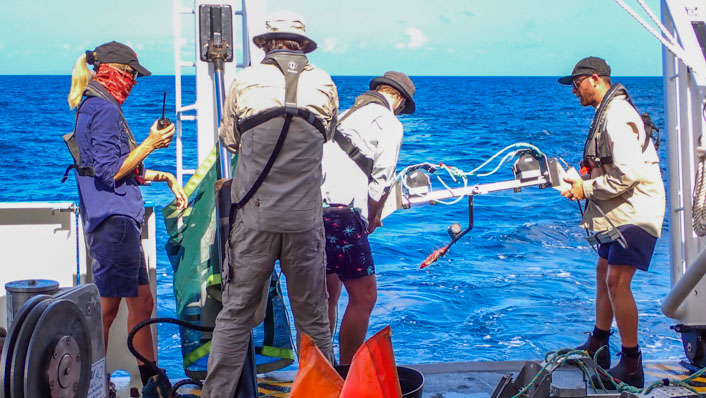In deep-water areas between reefs of the Great Barrier Reef, we know very little about the sustainability of popular commercial and recreational fishes, such as coral trout, nannygai and red emperor, or the variety and abundance of fish species in general.
For the first time in a dedicated monitoring program, AIMS scientists and collaborators have deployed baited remote underwater video stations (BRUVS) across the length and breadth of the Great Barrier Reef, to find out what fishes are where.
BRUVS are stereo camera stations placed on the seafloor that record fish attracted to a mesh bag full of minced pilchards positioned at the end of a bait arm. The footage is later analysed by specialists who identify the fish species and record their length and relative abundance.
Researchers use this common fish-surveying tool to observe fish in hard-to-reach areas, such as those beyond the depths of scientific scuba diving.

AIMS research project lead, Dr Stacy Bierwagen said trying to find these important fish species in under-surveyed areas can be like trying to find a needle in a haystack.
"When choosing sites to monitor, we used available habitat layers, management zones and historical data records from AIMS and project collaborators. The seafloor of these areas was then mapped using multibeam sonar to pinpoint the exact sites for BRUVS deployment," she said.
The thirty-one deep-water monitoring sites span the northern, central and southern regions of the Great Barrier Reef, and include areas open and closed to fishing across different habitats.
Over the field season, the team dropped more than 700 BRUVS, and deployed 134 ROVs or remotely operated vehicles to capture more than 720 hours of footage. The BRUVS observe and record fish at key monitoring sites, while the ROVs provide complimentary information on the habitats.
"We know very little about the fish communities that exist in these areas, so the initial BRUVS video analysis is revealing interesting insights." said Dr Bierwagen.
"The monitoring will fill knowledge gaps and establish a reference point to detect changes in these fish communities, which is important for managers and fisheries."
The research team will return to the field at the end of 2023, to undertake a second round of surveys at the same monitoring sites.
The BRUVS monitoring project is part of the two-year Integrated Monitoring and Reporting (IMR) Program and will observe fish in areas of the Great Barrier Reef that management and fisheries have little independent information about. Other project components are surveying juvenile fishes in nurseries close to shore and on reefs surrounding islands close to the coast.
The IMR Reef Fish Monitoring Program is funded by the partnership between the Australian Government's Reef Trust and the Great Barrier Reef Foundation. This is a collaborative project between AIMS, TropWATER: JCU's Centre for Tropical Water and Aquatic Ecosystem Research, Marine Data Tech, University of the Sunshine Coast, Traditional Owners from Girringun Aboriginal Corporation, Manbarra and Wulgurukaba, and with input from Department of Agriculture and Fisheries (Queensland) and the Great Barrier Reef Marine Park Authority.






